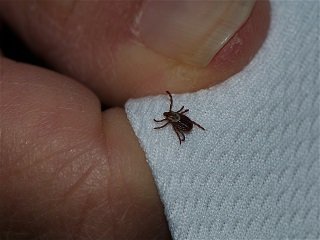 As the weather warms, several outdoor creatures are starting to become more active. However, deer and foxes aren’t the only critters on the move this spring; ticks will also begin to shake a leg as the temperatures rise. While outdoorsmen can’t really avoid the habitats where ticks live and thrive, they can take measures to avoid playing host to these little disease-carrying bloodsuckers. I’ve outlined a few tips for doing so today.
As the weather warms, several outdoor creatures are starting to become more active. However, deer and foxes aren’t the only critters on the move this spring; ticks will also begin to shake a leg as the temperatures rise. While outdoorsmen can’t really avoid the habitats where ticks live and thrive, they can take measures to avoid playing host to these little disease-carrying bloodsuckers. I’ve outlined a few tips for doing so today.
Due to the fact that most ticks crawl upward onto a host, it’s smart to tuck your pant legs into your boots, and also your shirts into your pants. Furthermore, for some extra protection in heavily tick infested regions, I suggest you tape these areas with duct tape, in order to increase your protection.
Due to their small size and dark coloration, it’s best to wear light-colored clothing when possible. This makes it easier to see ticks crawling on your clothing and remove them before they find their way to your skin. When you do return from the outdoors—light clothing or otherwise—it’s crucial to inspect all your clothing before going inside. Once inside, do a thorough full-body inspection and wash your clothing as soon as possible.
Strong bug repellent will always be your best line of defense against ticks, as well as other pests. For the best results, look for a repellent that contains 0.5 percent or more of permethrin. This works as a great tick repellent and can usually be safely used on clothing, even remaining in the clothing fibers after a few washes.
If you find a tick, remove it as soon as possible and disinfect the affected area immediately after doing so; this will lessen the chance of it transmitting a disease. The best way to remove a tick is to grasp it close to the skin with fine-tipped tweezers, parallel to the skin so that you grasp the base of the tick’s mouthparts rather than its body. Then, pull gently but firmly, straight away from the skin until the tick comes free. Keep in mind that it’s best to grasp the tick from its back to its belly, instead of from side to side, which helps to prevent the tick’s mouthparts from remaining imbedded in the skin.
Like most facets of the outdoors, taking the time to prepare yourself for potential tick encounters before venturing into the woods is the best way to start any trip. Keep the tips outlined above in mind this spring and summer and you’ll have a leg up on those little pests.








